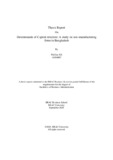| dc.contributor.advisor | Chowdhury, Suman Paul | |
| dc.contributor.author | Ali, Nafisa | |
| dc.date.accessioned | 2022-11-03T06:47:31Z | |
| dc.date.available | 2022-11-03T06:47:31Z | |
| dc.date.copyright | 2020 | |
| dc.date.issued | 2020-09 | |
| dc.identifier.other | ID 16304087 | |
| dc.identifier.uri | http://hdl.handle.net/10361/17552 | |
| dc.description | This thesis is submitted in partial fulfillment of the requirements for the degree of Bachelor of Business Administration, 2020. | en_US |
| dc.description | Cataloged from PDF version of thesis. | |
| dc.description | Includes bibliographical references (pages 27-29). | |
| dc.description.abstract | The determinants of a firm’s capital structure decisions may vary across countries. Determinants that affect significantly in a developing country, such as, Bangladesh, may affect differently for a developed country. Industry type, industry structure, government policies may impact here. This report titled: “Determinants of Capital structure: A study on non-manufacturing firms in Bangladesh” aims to investigate those determinants of capital structure that create value in leverage decision making procedure for Bangladeshi firms. I have randomly selected 100 listed non-manufacturing firms from the Dhaka Stock Exchange (DSE) over a five year period from 2015 to 2019 and obtained necessary secondary data. I have conducted a descriptive analysis, correlation matrix and regression analysis to obtain a clear view on the relationship of capital structure and its determinants. I have used both book based leverage and market based leverage in my study. Finally, the outcome of this study concludes that, firm size and growth can both have positive and negative relationship for mktlev model and booklev model respectively, performance may have positive and negative relationship for booklev and mktlev model respectively with capital structure for Bangladeshi firms. The other two determinants name tangibility and listing age have only positive relationship with capital structure. Due to time limitation, I couldn’t focus more in sample selection. Despite of this, I hope my findings will surely help others who wish to research on this topic in developing countries. | en_US |
| dc.description.statementofresponsibility | Nafisa Ali | |
| dc.format.extent | 29 pages | |
| dc.language.iso | en | en_US |
| dc.publisher | Brac University | en_US |
| dc.rights | Brac University theses are protected by copyright. They may be viewed from this source for any purpose, but reproduction or distribution in any format is prohibited without written permission. | |
| dc.subject | Capital structure | en_US |
| dc.subject | Firm size | en_US |
| dc.subject | Performance | en_US |
| dc.subject | Tangibility | en_US |
| dc.subject | Growth opportunity | en_US |
| dc.subject | Listing age | en_US |
| dc.subject | Debt | en_US |
| dc.subject | Firm- year | en_US |
| dc.subject.lcsh | Corporations Finance | |
| dc.subject.lcsh | Investments | |
| dc.title | Determinants of capital structure: a study on non-manufacturing firms in Bangladesh | en_US |
| dc.type | Thesis | en_US |
| dc.contributor.department | Brac Business School, Brac University | |
| dc.description.degree | B. Business Administration | |

